Pers. (1801)
What is Peziza?
The genus Peziza comprises about a hundred cosmopolitan fungal species. They are plant saprophytes, meaning that they obtain nutrients directly from dead plant matter, such as decayed wood, dung, heaps of manure, and soils with a high organic matter content [1].
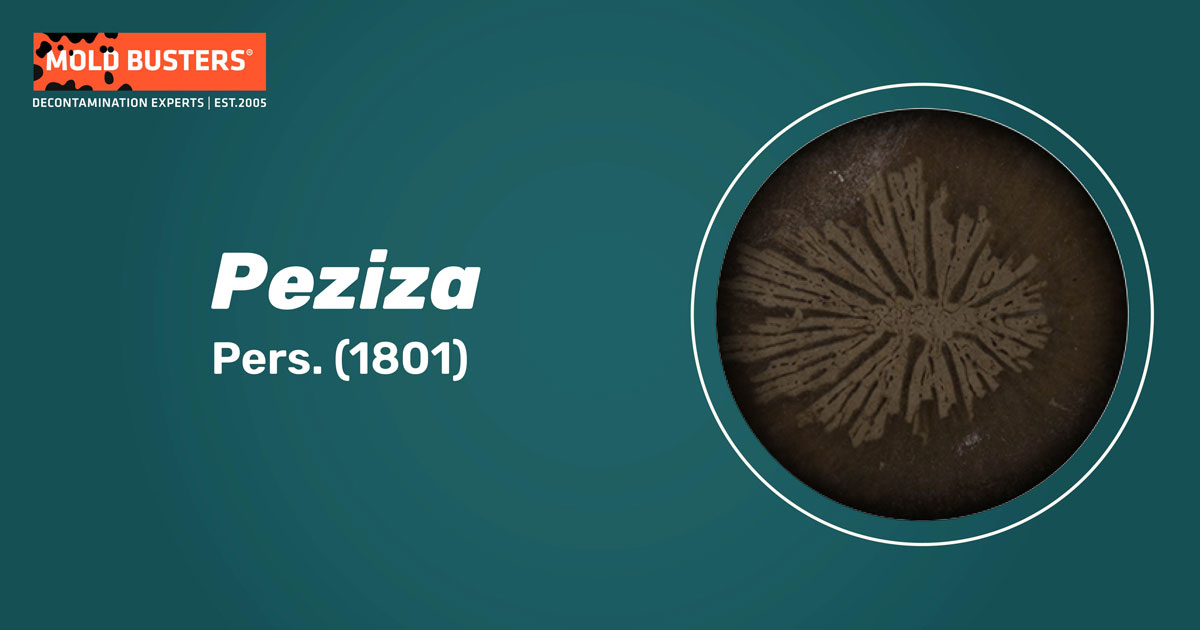
Classification of the genus Peziza
The genus Peziza belongs to the phylum Ascomycota, the class Pezizomycetes, and the order Pezizales. [1].
There are around 200 species of Peziza, with some prominent species being: P. vesiculosa, P. aurantia, P. rapanda, P. fuckeliana, P. ostracoderm, and P. domiciliana [1].
What does Peziza look like?
Peziza species are characterized by well-developed mycelium, consisting of a dense network of branched, septate hyphae. Every hyphal cell contains a single nucleus. Since the mycelium is hidden within the substratum or soil, in nature, Peziza is visible only when their fruit bodies (mushrooms) are formed on the substrate surface. Due to their cup-shaped fruit bodies (Fig. 1 and Fig 2.), Peziza species are commonly known as cup fungi [1].
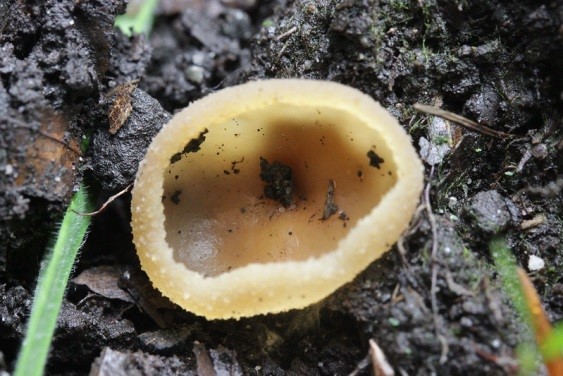
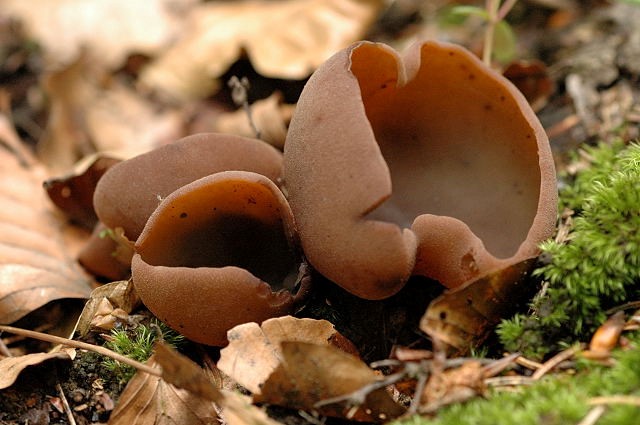
How does Peziza fungi reproduce?
In Peziza species, asexual reproduction is uncommon. Certain species produce asexual spore conidia, and their asexual stages are classified into the genera Oedocephalum and Chromelosporium. The conidia are formed exogenously (external formations), by separation from the tips of conidiophores. Each conidium germinates, forming a new vegetative mycelium [1].
Peziza spp. can also produce chlamydospores, which are thick-walled and formed within the hyphal cells. Their function is to enable fungi to survive in unfavorable conditions. Chlamydospores germinate under favorable conditions into the primary mycelium [1]. If the two primary mycelia, with compatible reproductive gene regions, merge, they can form a sexual stage. Sexual stages form the characteristic cup-like fruiting bodies which produce ascospores (sexual spores).
Ascospores are oval and enclosed inside of an ascus, which is elongated and cylindrical. During the process of formation of ascospores, the vegetative hyphae grow around the asci, forming an open fruiting body (apothecium). Apothecia (apothecium plur.) are sessile, about 2–6 cm (0.79–2.36 inches) in diameter, with erect asci lining the inner of their cavity, called the hymenium (Fig. 3). Between asci are sterile hyphae called paraphyses, while the rest of the fruiting body consists of supporting tissue. After dispersion, each ascospore germinates into a new mycelium [1].
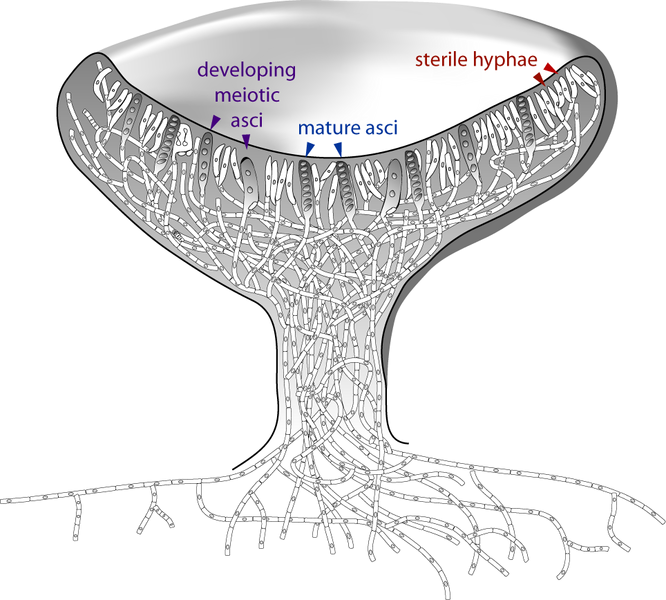
Where Peziza can be found?
Peziza species are commonly distributed in nature worldwide, while the species Peziza domiciliana is particularly known for growing on a wide range of domestic materials, such as plaster, cement, sand, coal dust, damp carpets, fireplace ashes, and walls (Fig. 4). Its presence has been reported in damp places, including living rooms, shower stalls, closets, walls behind refrigerators, surrounding leaking water beds, cellars, greenhouses, beneath porches, classroom walls, and cars. In gardens, Peziza domiciliana can be found on humus, soil, and rotten wood [2].
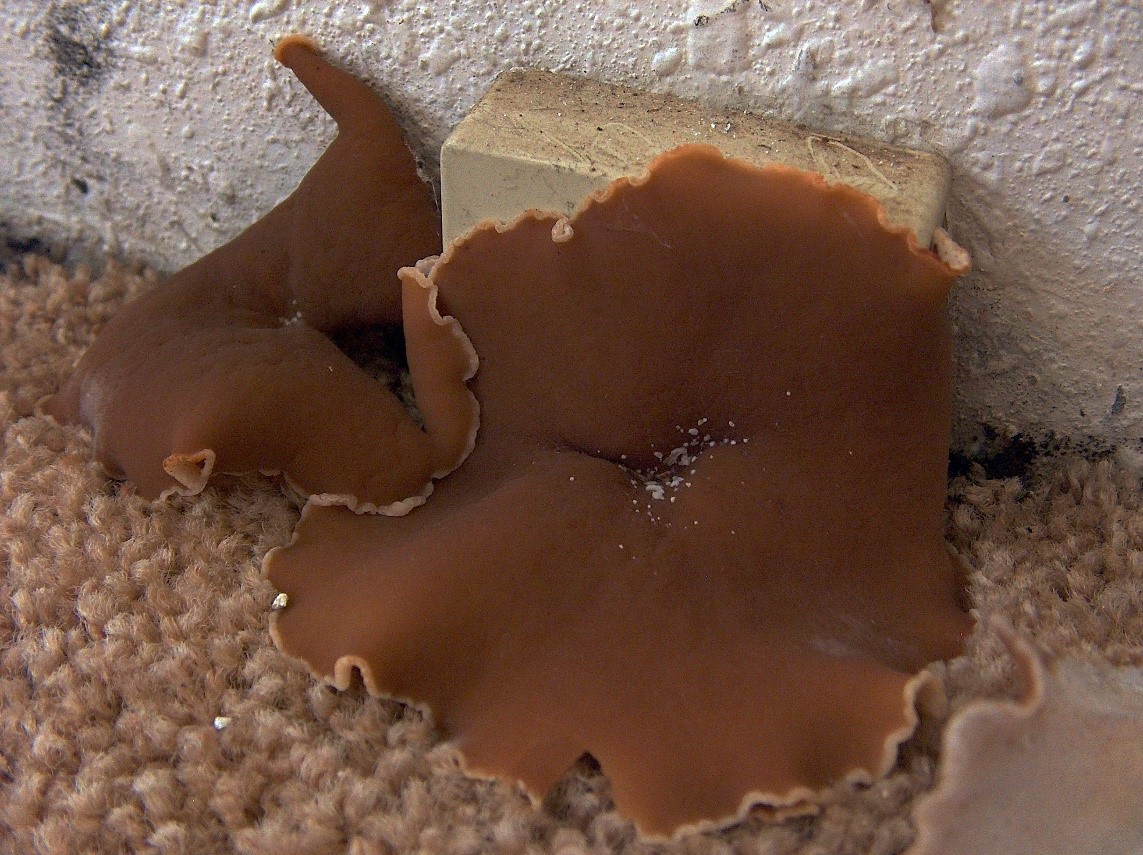
Is Peziza dangerous?
The genus Peziza is closely related to some very prized edible fungi, but due to its rubbery texture, it is considered non-edible. However, there is no specific information regarding the toxicity of Peziza species, except for Peziza vesiculosa, which is reported as poisonous [3].
Reports of adverse health effects of Peziza species are very scarce, while their allergenicity has not been studied so far. We found two cases reported of hypersensitivity pneumonitis linked to Peziza species.
The first one caused severe dyspnea in a previously healthy woman. The woman was diagnosed with restrictive lung disease and alveolitis. An examination of her house identified the mushroom in her basement, previously flooded due to heavy rains, and air sampling confirmed the presence of P. domiciliana spores [4].
The second case of hypersensitivity pneumonitis refers to P. ostrachoderma, which affected carnation cutting workers [5]. Spores of Peziza vesiculosa have also been found in higher concentrations in the airways of asthmatics, but it has not been studied if this species was involved in the development of asthma [5].
Where can you find Peziza indoor?
Like other saprophytic fungi, Peziza species are very ecologically important since they facilitate decomposition, increase soil fertility, and continue nutrient cycles. However, it can be very unpleasant if it colonizes someone’s kitchen, bathroom, carpet, or basement floor. While not considered toxic, Peziza species can still be potentially harmful if ingested accidentally by children or pets. Being a colonizer of damp places, Peziza can also indicate the presence of other potentially dangerous fungi linked to the sick building syndrome. Therefore, engaging equipped professionals is strongly recommended when cup fungi are noticed in the living or working space.
Like other saprophytes, Peziza often occurs due to a lack of competition from other microorganisms. It is capable of growing in a wide range of temperatures (20–42°C or 68–107.6°F) and pH (3–8). This can be very important for people who work at mushroom farms and those who deal with paper pots, peat, sterilized soil, vermiculite, and paper substrates. In such cases, the introduction of competitive microorganisms to suppress growth and outcompete Peziza strains might be a solution [5].

Did you know?
The #1 toxic mold type found in homes is the Penicillium/Aspergillus mold group?! Find out more exciting mold stats and facts inside our mold statistics page.
References
- Manoharachary, C. et al. (2016). Mycology and microbiology. Scientific Publishers, India. pp. 143-145.
- Peziza Retreated from: www.eurofins.com
- Arora D. (1986). Mushrooms Demystified: a Comprehensive Guide to the Fleshy Fungi. Berkeley, California: Ten Speed Press. pp. 822–823
- Wright, R. S. et al. (1999). Hypersensitivity pneumonitis from Pezizia domiciliana. A case of El Niño lung. American Journal of Respiratory and Critical Care Medicine. 160(5): 1758–1761.
- Madsen, A. M. and Crook. B. (2021). Occupational exposure to fungi on recyclable paper pots and growing media and associated health effects – A review of the literature. Science of The Total Environment. 788: 147832
- Featured photo image, retrieved from mnhn.fr

Get Special Gift: Industry-Standard Mold Removal Guidelines
Download the industry-standard guidelines that Mold Busters use in their own mold removal services, including news, tips and special offers:

Written by:
Jelena Somborski
Mycologist
Mold Busters
Edited by:
Dusan Sadikovic
Mycologist – MSc, PhD
Mold Busters
